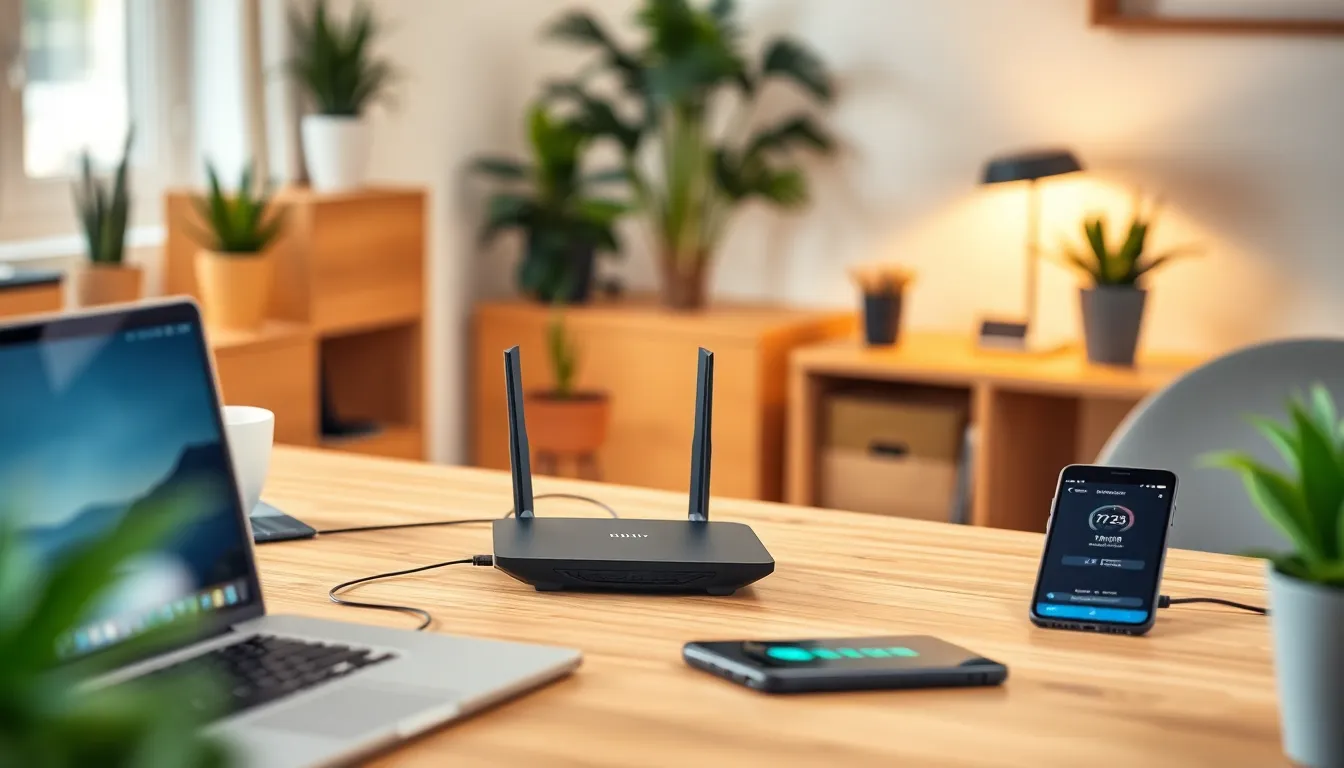In the vast universe of IP addresses, 192.168.7.1 stands out like a quirky neighbor who always has the best snacks at their door. This little number is a private IP address, often found lurking in the shadows of home networks, ready to help routers communicate with devices. Understanding it isn’t just for tech wizards; it’s for anyone who wants to tame their internet jungle.
Table of Contents
ToggleOverview of 1921687.1
192.168.7.1 serves as a private IP address essential for local networks. Many routers utilize this address to facilitate communication between devices within the network. Home users often encounter this IP when logging into router settings to manage configurations.
This specific address generally works within the IPv4 range reserved for private use. In many cases, devices assigned this IP can access the internet and connect to other devices seamlessly. The address’s role extends beyond basic connectivity; it also enhances security by limiting exposure to external threats.
Users can typically access their router’s settings by entering 192.168.7.1 into a web browser. This action redirects them to a login page, often requiring credentials for secure access. Network administrators appreciate this feature since it allows them to customize settings such as Wi-Fi passwords and parental controls.
Various devices might rely on this IP for local area network interactions. Printers, smart TVs, and smartphones often connect through 192.168.7.1. Connectivity issues can arise if two devices mistakenly receive the same IP, highlighting the need for proper management.
Learning about 192.168.7.1 equips users with knowledge vital for efficient network management. Resolving issues related to connectivity or security can save time and frustration. Mastery of this address enables users to optimize their home networks effectively.
Features of 1921687.1

192.168.7.1 serves as a critical component in home networking. Users benefit from various features that enhance connectivity and streamline router management.
User Interface
Accessing the user interface through 192.168.7.1 provides a straightforward experience. Navigation remains intuitive, allowing users to locate settings quickly. Essential configurations like Wi-Fi networks and security protocols appear clearly. Clear labeling of settings assists users in making adjustments without confusion. Customization options empower network administrators to tailor features according to personal needs. Admins often adjust bandwidth settings or implement parental controls effectively. A user-friendly design reduces the learning curve, accommodating those new to router management.
Performance Metrics
Performance metrics associated with 192.168.7.1 highlight its efficiency. Connectivity speeds often reach optimum levels due to direct access via this IP address. Network latency typically remains low, ensuring smooth online experiences. Data transfer rates reflect swift communication between devices linked to the router. Regular firmware updates can enhance performance even more. Signal strength remains consistent, crucial for seamless device operation within the local network. Monitoring these metrics provides insights into network health and allows users to identify issues swiftly. Proper performance management helps maintain an efficient and secure home network.
Installation Process
The installation process for 192.168.7.1 involves specific requirements and straightforward steps. This ensures effective router configuration that enhances network performance.
System Requirements
For accessing 192.168.7.1, a compatible device with web browser functionality is essential. Most current devices, including laptops smartphones and tablets, suffice for this purpose. An active internet connection aids in loading the router interface. Additionally, familiarity with router admin credentials supports a smooth login experience. Specific routers might also require a firmware version that supports access through this IP.
Step-by-Step Guide
Start by connecting the device to the router via Ethernet or Wi-Fi. Open a web browser and type 192.168.7.1 in the address bar. Hit enter to load the login page. Next, input the admin username and password; these details typically appear on the router label. Once logged in, explore the settings interface to adjust configurations, such as Wi-Fi security or parental controls. Save any changes made to ensure they take effect. Regularly monitor the network settings to maintain optimal performance and security.
Comparing 1921687.1 to Alternatives
192.168.7.1 stands out among other private IP addresses due to its specific applications. Common alternatives include 192.168.0.1 and 192.168.1.1, which serve similar roles in network management. Notably, 192.168.0.1 is often used by brands like Linksys, while 192.168.1.1 is frequently associated with Netgear and D-Link routers.
Functionality is one aspect where 192.168.7.1 excels, providing a straightforward interface for users. In contrast, some alternatives may offer complex navigation that can confuse less experienced users. Network administrators appreciate the simplicity of 192.168.7.1 when adjusting settings like security protocols and bandwidth control.
Security features also differentiate these IP addresses. Through 192.168.7.1, users gain access to enhanced security configurations, which can improve overall network safety. Alternatives such as 192.168.0.1 and 192.168.1.1 might not offer the same level of insight into security threats, potentially leaving users more vulnerable.
Performance-related metrics reveal strong points for each address. Indicators of efficiency, such as low latency and high connectivity speeds, are often comparable. However, users find that 192.168.7.1 frequently maintains consistent signal strength, making it preferable for users with multiple devices.
While installation procedures vary slightly among these addresses, the steps remain mostly similar. Users typically require a compatible device and internet connection to access router settings. Entering the IP address directly into a web browser remains a common method for initiating access across all options.
Pros and Cons of 1921687.1
192.168.7.1 offers several benefits, enhancing its role in home networking. This IP address provides a secure means for devices to communicate without exposure to external threats. Enhanced privacy measures protect sensitive data, which is vital in today’s digital landscape.
User-friendly interfaces simplify access to router settings. Users can swiftly navigate to important configurations, including Wi-Fi passwords and parental controls. Regular firmware updates boost performance, ensuring optimal connectivity speeds and low latency.
Some drawbacks exist with 192.168.7.1. Limited manufacturer support may present challenges when troubleshooting specific devices. Not all routers utilize this IP address, which can cause confusion for users trying to access settings.
Networking issues can arise with IP conflicts when multiple devices connect using the same IP. Such conflicts lead to connectivity problems, reducing overall network efficiency. It’s crucial for users to monitor network settings and avoid these potential pitfalls.
Comparisons to alternative private IP addresses show distinct differences. While addresses like 192.168.0.1 and 192.168.1.1 are popular, 192.168.7.1 excels in direct access and strong security features. Users often find this address suits their needs, particularly when managing multiple devices.
Ultimately, 192.168.7.1 serves as a robust option for home networks. Its advantages in usability and security outweigh the limitations, making it a preferred choice among users. Understanding these pros and cons allows for informed decisions when managing home network configurations.
192.168.7.1 stands out as a vital component in home networking. Its user-friendly interface and robust security features make it an excellent choice for managing local networks. By understanding and utilizing this IP address, users can optimize their internet connections and enhance their overall network experience.
Regular monitoring and updates ensure that devices remain connected and secure. With its specific advantages over alternative private IP addresses, 192.168.7.1 proves to be a reliable option for both novices and experienced network administrators. Embracing this knowledge empowers users to take control of their home networks confidently.



